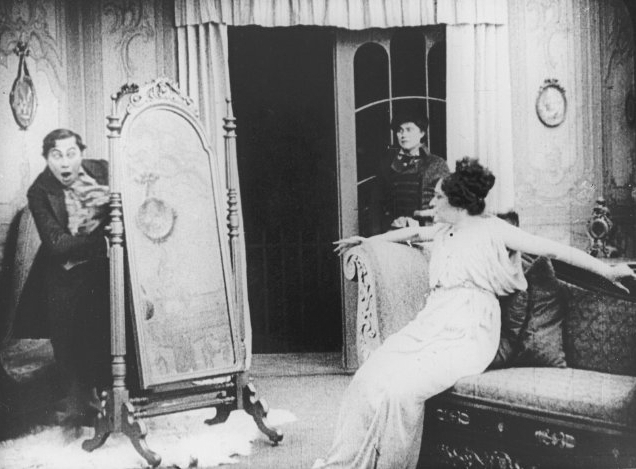
Ekspresionistički klasik s reputacijom "prvog" autorskog, umjetničkog i horror filma (tema Doppelgängera).

In his authoritative book Weimar Culture, Peter Gay makes the point that many of the artistic innovations that we associate with Weimar Germany actually originated beforehand. Silent movie The Student of Prague is a perfect example. Created in 1913, and thus a full five years before the end of the Second Reich, its eerie mood, technical accomplishment and literary inspiration seem to belong in one of the great 1920s Expressionist movies.
Like the film Richard Wagner, created the same year, The Student of Prague was so ahead of its time that it achieved multiple “firsts”. It is described as the first art film, the first horror film and the first auteur film, said auteur being Hanns Heinz Ewers, who wrote and directed (his co-directors being Stellan Rye and star Paul Wegener, although the division of directorial duties is disputed). Ewers saw the new medium of cinema as the perfect vehicle for the macabre atmosphere he had created in books like Alraune.
While the film’s Faustian bargain inevitably brings Goethe to mind, Ewers also drew on two other works, Alfred de Musset‘s poem “Night of December” and Edgar Allan Poe’s story “William Wilson”. Common to both is the theme of the doppelgänger, brilliantly explored in the film with the then revolutionary use of double exposure. Psychoanalyst Otto Rank picked up on the film in his 1914 essay “The Doppelgänger”, and no less a personage than Sigmund Freud mentioned The Student of Prague in the 1919 study “The Uncanny”. In Movies and the Modern Psyche, Sharon Packer comments that the film “bridged the supernatural and the psychological and connected the soul to the psyche,” creating “a metaphor about the struggles of early twentieth-century society, and its attempts to reconcile ancestral spiritual ideas with the advances in science, technology and psychology.”
The Student of Prague premiered in Berlin’s Theater am Nollendorfplatz in summer 1913. It launched the film careers of its two main actors, both making their debut. Paul Wegener went on to appear in three different films dealing with the legend of the Golem, while John Gottowt would be seen in pioneering science fiction Algol and later Nosferatu. Further versions of Ewers’ story appeared in 1926 and 1935.
A restored print of the entire 83 minute film was presented at Berlinale earlier this year. What appears below is a flawed, much shorter version which should be considered an approximation of the real thing. - James Conway
The Student of Prague (German: Der Student von Prag, also known as A Bargain with Satan) is a 1913 German silent horror film. The film was remade in 1926, under the same title The Student of Prague. Other remakes were produced in 1935 and 2004.
A poor student rescues a beautiful countess and soon becomes obsessed with her. A sorcerer makes a deal with the young man to give him fabulous wealth and anything he wants, if he will sign his name to a contract (i.e. make a Deal with the Devil). The student hurriedly signs the contract, but doesn't know what he's in for.
A long plot summary is given by psychologist Otto Rank in The Double (1971; originally "Der Doppelgänger" in Imago III.2, 1914, 97-164).
The film is referenced in the detective story "The Image in the Mirror" by Dorothy Sayers, in which Lord Peter Wimsey helps clear Mr. Duckworthy, a man wrongly suspected of murder. Among other things Duckworthy tells:
"When I was seven or eight, my mother took me with her to see a film called "The Student of Prague".(...) It was a costume piece about a young man at the university who sold himself to the devil, and one day his reflection came stalking out of the mirror on its own, and went about committing dreadful crimes, so that everybody thought it was him".(In the story, Mr. Duckworthy had what seemed a similar experience - but Wimsey eventually proves that it had a rational explanation involving no supernatural agency). - wikipedia

Nema komentara:
Objavi komentar